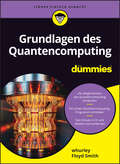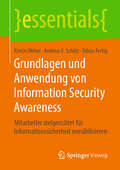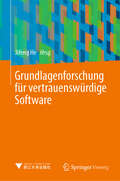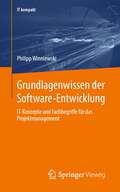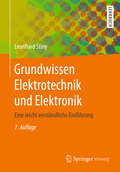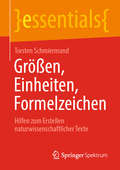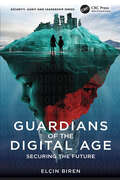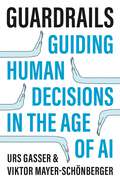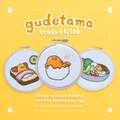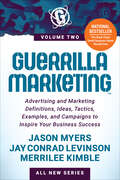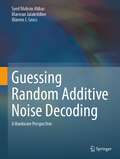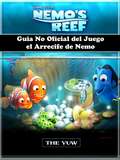- Table View
- List View
Grundlagen des Quantencomputing für Dummies (Für Dummies)
by Floyd Earl Smith whurleyTauchen Sie ein in die Welt des Quantencomputing! In diesem Buch erfahren Sie, wieso Quantencomputer Probleme lösen können, für die Supercomputer Millionen von Jahren brauchen würden. Die Autoren zeigen Ihnen, welche wirtschaftlichen Potenziale das Quantencomputing für Ihr Unternehmen birgt und wie es Ihre Arbeit unterstützen kann. Sie vermitteln Ihnen nicht nur die Grundlagen, sondern zeigen Ihnen ganz konkret, wie das Quantencomputing Industrien wie das Finanzwesen, Transportwesen, die Pharmazie und Cybersecurity transformieren wird. Um Quantencomputing und sein Potenzial verstehen zu können, benötigen Sie keinen Doktortitel, sondern nur dieses Buch. Sie erfahren Welche Arten von Quantencomputern existieren und was sie unterscheidet Was Quantencomputing schon heute kann Wie Sie Ihr Unternehmen auf Quantencomputing vorbereiten Wie Sie Ihr erstes eigenes Quantencomputing-Programm schreiben
Grundlagen des parallelen wissenschaftlichen Rechnens: Ein erster Leitfaden zu numerischen Konzepten und Programmiermethoden
by Tobias WeinzierlNeue Erkenntnisse in vielen wissenschaftlichen und technischen Bereichen sind ohne den Einsatz numerischer Simulationen, die auf modernen Computern effizient ablaufen, nicht denkbar. Je schneller wir neue Ergebnisse erhalten, desto größer und genauer sind die Probleme, die wir lösen können. Es ist die Kombination aus mathematischen Ideen und effizienter Programmierung, die den Fortschritt in vielen Disziplinen vorantreibt. Zukünftige Meister auf diesem Gebiet müssen daher in ihrem Anwendungsgebiet qualifiziert sein, sie brauchen ein tiefes Verständnis einiger mathematischer Ideen und sie müssen die Fähigkeiten haben, schnellen Code zu liefern.Das vorliegende Lehrbuch richtet sich an Studierende, die bereits über Programmierkenntnisse verfügen und die Mathematik nicht scheuen, auch wenn sie eine Ausbildung in Informatik oder einem Anwendungsbereich haben. Es führt in die grundlegenden Konzepte und Ideen hinter der angewandten Mathematik und der parallelen Programmierung ein,die wir brauchen, um numerische Simulationen für die heutigen Multicore-Workstations zu schreiben. Unsere Absicht ist es nicht, in einen bestimmten Anwendungsbereich einzutauchen oder eine neue Programmiersprache einzuführen - wir legen die allgemeinen Grundlagen für zukünftige Kurse und Projekte in diesem Bereich.Der Text ist in einem zugänglichen Stil geschrieben, der auch für Studenten ohne jahrelange Mathematikausbildung leicht zu verstehen ist. Er legt mehr Wert auf Klarheit und Intuition als auf Formalismus und verwendet eine einfache N-Körper-Simulation zur Veranschaulichung grundlegender Ideen, die in verschiedenen Teilbereichen des wissenschaftlichen Rechnens von Bedeutung sind. Sein primäres Ziel ist es, theoretische und paradigmatische Ideen für Studierende im Grundstudium zugänglich zu machen und die Faszination des Fachgebiets zu vermitteln.
Grundlagen und Anwendung von Information Security Awareness: Mitarbeiter zielgerichtet für Informationssicherheit sensibilisieren (essentials)
by Kristin Weber Andreas E. Schütz Tobias FertigKristin Weber, Andreas E. Schütz und Tobias Fertig zeigen in diesem essential, wie Mitarbeiter in acht Schritten für das Thema Informationssicherheit sensibilisiert werden können. Vorgestellt wird ein Vorgehen, welches Erkenntnisse aus der Verhaltenspsychologie berücksichtigt und somit eine passgenaue Auswahl von Sensibilisierungsmaßnahmen erlaubt. Projektbeispiele illustrieren die Umsetzbarkeit des Modells. Damit beschreiben die Autoren eine konkret anwendbare Methode, die auch bei kleinem Budget eine erfolgreiche Mitarbeitersensibilisierung verspricht.
Grundlagenforschung für vertrauenswürdige Software
by Jifeng HeIn diesem Buch werden vor allem der Forschungsüberblick, die Forschungsergebnisse und die weiteren Aussichten von "The Fundamental Research for Trustworthy Software", einem großen Forschungsprojekt des NSFC, vorgestellt. Das Projekt konzentriert sich auf vier wissenschaftliche Kernthemen: Messung und Modellierung der Software-Glaubwürdigkeit, Konstruktion und Verifizierung vertrauenswürdiger Software, Entwicklung und Kontrolle vertrauenswürdiger Software sowie Konstruktion und Bewertung einer vertrauenswürdigen Umgebung. Es konzentriert sich auf die Glaubwürdigkeit von embedded Software und Netzwerkanwendungssoftware und nimmt die Glaubwürdigkeit von Software in nationalen Schlüsselanwendungsbereichen als einen Durchbruch, um einen Forschungsrahmen für die Grundlagenforschung von vertrauenswürdiger Software zu schaffen.
Grundlagenwissen der Software-Entwicklung: IT-Konzepte und Fachbegriffe für das Projektmanagement (IT kompakt)
by Philipp WinniewskiDas Buch erklärt wichtige Begriffe der modernen Software-Entwicklung. Sämtliche Ausführungen betrachten das jeweilige Thema aus Sicht eines Managers mit Fokus auf die Bedeutung im unternehmerischen Prozess der Entwicklung einer Software und weniger aus der Perspektive eines Programmierers. Die vermittelten Kenntnisse dienen als Basis, um technologische Probleme in ihrer Schwere und Komplexität erfassen und Entscheidungen in ihrer Auswirkung einschätzen zu können. Zudem ermöglicht das dargebotene Grundwissen eine unmissverständliche und reibungslose Kommunikation zwischen IT-Fachkräften und der Zielgruppe der Manager. Das Werk beschränkt sich nicht nur auf eine Zusammenfassung aller wichtigen Fakten zu einem Thema, sondern vermittelt auch den Umgang in der Praxis und damit verbundene Vor- und Nachteile bzw. potentielle Gefahren.
Grundwissen Elektrotechnik und Elektronik: Eine leicht verständliche Einführung
by Leonhard StinyDas Buch vermittelt die Grundlagen der Elektrotechnik und Elektronik in einer Form, die auch für den Anfänger ohne Kenntnisse in höherer Mathematik oder komplexer Physik geeignet ist. Fortgeschrittene finden ferner mathematisch anspruchsvollere Abschnitte zur Vertiefung. Ein großer Vorteil des Buches liegt in der äußerst logischen inhaltlichen Gliederung und in einer klaren Sprache. Es wird stets vom Einfachen zum Schwierigeren fortgeschritten und darauf geachtet, dass Fachbegriffe nicht als bekannt vorausgesetzt werden. Am Anfang wird von einfachen mechanischen Modellvorstellungen mit bildhaften Vergleichen zur Elektrizität ausgegangen. Später folgt ein Übergang zu formalen physikalischen Betrachtungen, die durch mathematische Zusammenhänge beschrieben werden. Zahlreiche Übungsaufgaben mit ausführlichen Lösungen ermöglichen ein Selbststudium. Durch die Berechnung eines gleichen Sachverhaltes mit unterschiedlichen Analyseverfahren werden mögliche Vorgehensweisen geübt.
Grundwissen Elektrotechnik und Elektronik: Eine leicht verständliche Einführung
by Martin Poppe Leonhard StinyDas Buch vermittelt die Grundlagen der Elektrotechnik und Elektronik in einer Form, die auch für den Anfänger ohne Kenntnisse in höherer Mathematik oder komplexer Physik geeignet ist. Fortgeschrittene finden ferner mathematisch anspruchsvollere Abschnitte zur Vertiefung. Ein großer Vorteil des Buches liegt in der äußerst logischen inhaltlichen Gliederung und in einer klaren Sprache. Es wird stets vom Einfachen zum Schwierigeren fortgeschritten und darauf geachtet, dass Fachbegriffe nicht als bekannt vorausgesetzt werden. Am Anfang wird von einfachen mechanischen Modellvorstellungen mit bildhaften Vergleichen zur Elektrizität ausgegangen. Später folgt ein Übergang zu formalen physikalischen Betrachtungen, die durch mathematische Zusammenhänge beschrieben werden. Zahlreiche Übungsaufgaben mit ausführlichen Lösungen ermöglichen ein Selbststudium. Durch die Berechnung eines gleichen Sachverhaltes mit unterschiedlichen Analyseverfahren werden mögliche Vorgehensweisen geübt.
Grundzüge der Wirtschaftsinformatik
by Thomas Hess Matthias Schumann Peter Mertens Peter Buxmann Jan Muntermann Oliver HinzDiese Einführung in die Wirtschaftsinformatik ist bewusst kompakt gehalten. Dennoch sind alle wesentlichen Teilgebiete dargestellt und die Leitidee der Vernetzung und Integration zieht sich systematisch durch das Buch. Dadurch liefert es einen sehr guten Einblick in die mit IT unterstützten betrieblichen Aufgaben. Ausgehend vom Basiswissen zu Rechnern, ihrer Vernetzung sowie den verfügbaren Diensten werden die Grundlagen des Daten- und Wissensmanagements, von Big Data und KI behandelt. Die Unterstützung betrieblicher Funktionen und Prozesse durch die IT wird erläutert. Dabei wird die IT-basierte Einbindung privater Haushalte berücksichtigt. Neben dem IT-Management zeigen die Autoren, welchen Beitrag die IT zur digitalen Transformation leisten kann, von der Arbeitsplatzebene bis zur Neugestaltung des Geschäftsmodells eines Unternehmens. Das Buch eignet sich für Praktiker, die einen schnellen Überblick erhalten wollen, sowie für Studierende und Lehrende an Hochschulen und Berufsakademien.Neu in der 13. Auflage: Die Konzepte der Digitalisierung, des digitalen Wandels und die Voraussetzungen in Wirtschaft und Gesellschaft (technische Innovationen, Strukturen, Kultur, Steuerung) werden ausführlich dargestellt. Ergänzt wurden die Themen Künstliche Intelligenz, Cloud Computing, Edge Computing, Hochleistungsrechner (Supercomputer) sowie Beispiele zur Automatisierung im Produktionssektor durch Kommunikation zwischen Fertigungsmaschinen, Lagersteuerung, Logistik (Industrie 4.0), aber auch Weiterentwicklungen bei Finanzdienstleistungen (Zahlungsverkehr, Elektronische Handelssysteme, Marktdatensysteme, Kernbankensysteme). Vorgestellt werden moderne Ansätze der Software- und Systementwicklung, wie Agile Methoden oder Low-Code-Lösungen.
Grunt Cookbook
by Jurie-Jan BothaThis book will be useful to anyone who wishes to build anything from a static website to a more modern web application. Some basic JavaScript experience is preferable and some rudimentary knowledge of the Node.js platform could also come in handy.
Grupo Prisa: Media Power in Contemporary Spain (Global Media Giants)
by Luis A. Albornoz Núria Almiron Ana I. SegoviaIn one of the first English-language studies of Grupo Prisa, this book delivers a comprehensive and concise approach to the political, economic and social-cultural profile of one of the leading cross-media conglomerates in Europe, tracing its development from a single newspaper publisher in 1972. Prisa is now the world’s leading Spanish and Portuguese-language media group in the creation and distribution of content in the fields of culture, education, and information, producing content for more than twenty countries with global brands like El País (newspaper), Los 40 (radio), or Santillana (education). Using a critical political economy approach, the authors track Prisa’s journey to becoming a cross-media conglomerate, and examine how it mirrors the recent history of the economic and political developments in Spain. This concise and highly contemporary volume is ideal for students, scholars and researchers looking to further their understanding of a growing Spanish-language media power, or more generally interested in international communication and media industries.
Größen, Einheiten, Formelzeichen: Hilfen zum Erstellen naturwissenschaftlicher Texte (essentials)
by Torsten SchmiermundSie müssen einen naturwissenschaftlich-technischen Aufsatz schreiben und stehen nun vor dem Problem, ihre wenigen Formeln und Gleichungen korrekt darstellen zu wollen? Sie besitzen bereits Bücher zum Thema „Schreiben einer wissenschaftlichen Arbeit“, möchten zusätzlich aber erfahren, wie Sie bestimmte Sonderzeichen erzeugen können? Sie kennen sich in der Materie schon ganz gut aus, möchten aber regelkonform schreiben? Dieses essential liefert Ihnen Antworten in komprimierter Form. Neben allgemeinen Tipps erhalten Sie auch solche für das Arbeiten mit MS Word und darüber hinaus Informationen zum Umgang mit MS Excel, MS Powerpoint, OpenOffice und LibreOffice.
Guardians of Data: A Comprehensive Guide to Digital Data Protection
by Nik Zulkarnaen Khidzir Shekh Abdullah-Al-Musa AhmedThis book helps to reduce the risk of data loss by monitoring and controlling the flow of sensitive data via network, email, or web. Guardians of Data also shows guidance about data protection that data is not corrupted, is accessible for authorized purposes only, and is in compliance with applicable legal or regulatory requirements.Guardians of data means protecting data, networks, programs, and other information from unauthorized or unattended access, destruction, or change. In today’s world, guardians of data are very important because there are so many security threats and cyber-attacks. For data protection, companies are developing cybersecurity software.The primary goal of data protection is not just to safeguard sensitive information but to ensure it remains accessible and reliable, thus preserving trust and compliance in data-centric operations. While data protection laws set out what should be done to ensure everyone’s data is used properly and fairly, data protection is a backup solution that provides reliable data protection and high accessibility for rapidly growing business data. Data protection offers comprehensive backup and restoration of functionality specifically tailored for enterprises and distributed environments.
Guardians of the Digital Age: Securing the Future (Security, Audit and Leadership Series)
by Elçin BirenThe internet wasn’t built for time travelers. But when ethical hacker and mother Elsa and her 14-year-old son, Aiden, uncover a hidden code buried deep within cyberspace, they are pulled into a high-stakes journey through cybersecurity history—from the birth of ARPANET in 1969 to the AI-driven cyberwars of 2040. Their mission? Trace the origins of digital security before an unknown force alters history and reshapes the future of technology forever. As they jump across decades, they encounter internet pioneers, legendary hackers, and cyber-rebels who changed the digital world. But not everything in the past wants to stay in the past. Real dangers lurk in the timeline. Elsa and Aiden must navigate malware, mass surveillance, cyberwarfare, and a growing mystery that threatens the foundation of the internet itself. As they race against time, they also face their own fears and shifting trust in each other. A thrilling bridge between past and future, this book introduces parents and teens to the evolution of the internet and the most essential skill of our time—digital security. "The future is written in code—but cybersecurity is about trust and humanity. Will they protect it, or rewrite it?"
Guardrails: Guiding Human Decisions in the Age of AI
by Viktor Mayer-Schönberger Urs GasserHow society can shape individual actions in times of uncertaintyWhen we make decisions, our thinking is informed by societal norms, &“guardrails&” that guide our decisions, like the laws and rules that govern us. But what are good guardrails in today&’s world of overwhelming information flows and increasingly powerful technologies, such as artificial intelligence? Based on the latest insights from the cognitive sciences, economics, and public policy, Guardrails offers a novel approach to shaping decisions by embracing human agency in its social context.In this visionary book, Urs Gasser and Viktor Mayer-Schönberger show how the quick embrace of technological solutions can lead to results we don&’t always want, and they explain how society itself can provide guardrails more suited to the digital age, ones that empower individual choice while accounting for the social good, encourage flexibility in the face of changing circumstances, and ultimately help us to make better decisions as we tackle the most daunting problems of our times, such as global injustice and climate change.Whether we change jobs, buy a house, or quit smoking, thousands of decisions large and small shape our daily lives. Decisions drive our economies, seal the fate of democracies, create war or peace, and affect the well-being of our planet. Guardrails challenges the notion that technology should step in where our own decision making fails, laying out a surprisingly human-centered set of principles that can create new spaces for better decisions and a more innovative and prosperous society.
Gudetama Cross-Stitch: 30 Easy-to-Follow Patterns from Your Favorite Lazy Egg
by Sosae Caetano Dennis CaetanoGudetama Cross-Stitch combines cross-stitching fun with 30 easy-to-follow patterns inspired by everyone's favorite lazy egg with the can't-be-bothered attitude. Gudetama&’s name literally translates to &“lazy egg,&” and it&’s how we all feel sometimes when it comes to, well, pretty much anything. But if you&’re the kind of person who doesn&’t have time for complicated crafts or dealing with other people, then this collection of 30 Gudetama-inspired designs are just for you. First, you&’ll learn cross-stitching basics including tools and techniques and how to read a cross-stitch chart. Then you&’ll apply your new skills to a range of hilarious and lovable patterns organized into chapters like Lazy, Medium-Lazy, and Pay Attention—depending on how sluggish or motivated you&’re feeling. Finally, you&’ll be able to apply your masterpieces to projects like gift tags, greeting cards, and ornaments. Whether you&’re an experienced cross-stitcher or new to the craft, you&’ll find a variety of poses and patterns in this book that are accessible and easy to learn. With a little patience and practice, anyone can bring these Gudetama-inspired masterpieces to life. And if not, just take a nap.
Guerilla Data Analysis Using Microsoft Excel
by Oz Du Soleil Bill JelenThis book includes step-by-step examples and case studies that teach users the many power tricks for analyzing data in Excel. These tips have been honed by Oz du Soleil, a former financial analyst charged with taking mainframe data and turning it into useful information quickly, and “Mr. Excel” himself, Bill Jelen. Topics include data quality, validation, perfectly sorting with one click, matching lists of data, data consolidation, data subtotals, pivot tables, pivot charts, tables, and much more. This new edition has been updated for Excel 2013.
Guerrilla Marketing: Advertising and Marketing Definitions, Ideas, Tactics, Examples, and Campaigns to Inspire Your Business Success
by Jay Conrad Levinson Jason Myers Merrilee KimbleFocused on low-cost, strategic marketing concepts that will creatively promote a compelling product or service, Guerrilla Marketing’s winning approach relies on knowledge, time, energy, and imagination rather than a big marketing budget. Now, the winning continues with Guerrilla Marketing Volume 2.
Guerrilla Networks: An Anarchaeology of 1970s Radical Media Ecologies (Recursions)
by Michael GoddardThe radical youth movements of the 1960s and '70s gave rise to both militant political groups ranging from urban guerrilla groups to autonomist counterculture, as well as radical media, including radio, music, film, video, and television. This book is concerned with both of those tendencies considered as bifurcations of radical media ecologies in the 1970s. While some of the forms of media creativity and invention mapped here, such as militant film and video, pirate radio and guerrilla television, fit within conventional definitions of media, others, such as urban guerrilla groups and autonomous movements, do not. Nevertheless what was at stake in all these ventures was the use of available means of expression in order to produce transformative effects, and they were all in different ways responding to ideas and practices of guerrilla struggle and specifically of guerrilla media. This book examines these radical media ecologies as guerrilla networks, emphasising the proximity and inseparability of radical media and political practices.
Guessing Random Additive Noise Decoding: A Hardware Perspective
by Warren J. Gross Syed Mohsin Abbas Marwan JalaleddineThis book gives a detailed overview of a universal Maximum Likelihood (ML) decoding technique, known as Guessing Random Additive Noise Decoding (GRAND), has been introduced for short-length and high-rate linear block codes. The interest in short channel codes and the corresponding ML decoding algorithms has recently been reignited in both industry and academia due to emergence of applications with strict reliability and ultra-low latency requirements . A few of these applications include Machine-to-Machine (M2M) communication, augmented and virtual Reality, Intelligent Transportation Systems (ITS), the Internet of Things (IoTs), and Ultra-Reliable and Low Latency Communications (URLLC), which is an important use case for the 5G-NR standard. GRAND features both soft-input and hard-input variants. Moreover, there are traditional GRAND variants that can be used with any communication channel, and specialized GRAND variants that are developed for a specific communication channel. This book presents a detailed overview of these GRAND variants and their hardware architectures. The book is structured into four parts. Part 1 introduces linear block codes and the GRAND algorithm. Part 2 discusses the hardware architecture for traditional GRAND variants that can be applied to any underlying communication channel. Part 3 describes the hardware architectures for specialized GRAND variants developed for specific communication channels. Lastly, Part 4 provides an overview of recently proposed GRAND variants and their unique applications.This book is ideal for researchers or engineers looking to implement high-throughput and energy-efficient hardware for GRAND, as well as seasoned academics and graduate students interested in the topic of VLSI hardware architectures. Additionally, it can serve as reading material in graduate courses covering modern error correcting codes and Maximum Likelihood decoding for short codes.
Guia Blossom Blast Saga
by Hiddenstuff Entertainment Leonardo MagalhãesGuia de Dicas e Estratégia Avançada. Este é o guia mais abrangente e detalhado da internet. Disponível para download imediato em seu celular, dispositivo de eBook, ou brochura. Com o sucesso das centenas de guias e estratégias, escrevi outro guia profissional avançado para jogadores novos e veteranos. Este oferece estratégias e dicas específicas sobre como progredir no jogo, derrotar seus oponentes, adquirir mais moedas, e muito mais! Eis o que você terá ao comprar este guia profissional detalhado e avançado. - Dicas e Estratégias Profissionais. - Truques e Macetes. - Segredos, Dicas, Macetes e Truques usados por jogadores experientes! - Como conseguir várias moedas. - E MUITO MAIS! Todas as versões deste guia possuem imagens de tela para lhe ajudar a entender melhor o jogo. Nenhum outro guia é tão abrangente e avançado como este. Você irá gostar de ter comprado este guia, e terá muitos benefícios em comparação a outros guias menos eficazes por aí. Compre agora e destrua seus oponentes! Torne-se um Jogador Experiente Hoje! Para suporte e mais informações sobre nossos produtos, visite: http://www.hiddenstuffentertainment.com/.
Guia No Oficial del Juego el Arrecife de Nemo
by Adriana Rojas The YuwGuía avanzada de tips y estrategias. Esta es la única guía más comprensible y detallada que podrás encontrar en línea. Disponible para descargarse instantáneamente en tu teléfono móvil, equipo de libros electrónicos, o en un formato de papel. Con el éxito de cientos de otras guías escritas y estrategias que he escrito otra guía profesional avanzada para jugadores nuevos y veteranos. Esta da estrategias específicas y tips en cómo avanzar en el juego, vencer a tu oponentes, adquirir más moneras y dinero, mas ¡muchas otras cosas! - Tips y estrategias profesionales. - Trucos y consejos. - ¡Secretos, Tips, Mañas, Desbloqueadores, and Trucos usados por los jugadores profesionales! - Como obtener miles de Dinero/Monedas. - ¡Y MUCHO MÁS! Todas las versiones de esta guía tiene impresiones de pantalla para ayudarte a un mayor entendimiento del juego. No hay otra guía que sea tan comprensible y avanzada como esta.
Guia Não Oficial do Jogo Candy Crush Jelly Saga
by Débora L. Sousa Hiddenstuff EntertainmentPasse níveis, obtenha power-ups e a pontuação máxima! *GUIA NÃO OFICIAL* Além de comprar este e-book, fique à vontade para se inscrever no nosso programa suplementar de guias gratuitos. Ao copiar o link abaixo, você terá acesso às atualizações mais recentes dos aplicativos e videogames online mais populares. Inscreva-se gratuitamente abaixo: http://emailsignupform.subscribemenow.com/ Guia Avançado de Dicas e Estratégias. Este é o guia mais completo e detalhado que você encontrará online. Disponível para download instantâneo no seu celular, dispositivo para e-books ou em formato impresso. Com o sucesso das minhas centenas de outros guias e estratégias, resolvi escrever outro guia profissional avançado para os jogadores novos e veteranos. Ele apresenta estratégias e dicas específicas sobre como avançar no jogo, derrotar os seus adversários, adquirir mais moedas e dinheiro e muito mais! Você receberá o seguinte quando comprar este guia de jogo profissional avançado e detalhado: - Dicas e estratégias profissionais - Trapaças e hacks - Segredos, dicas, trapaças e truques usados por jogadores profissionais - Como ganhar muito dinheiro/moedas - E MUITO MAIS! Todas as versões deste guia têm capturas de tela para ajudar a entender melhor o jogo. Não existe outro guia tão completo e avançado como este. Você agradecerá por ter comprado este guia e será bastante beneficiado quando comparado com outros guias menos eficazes por aí. Compre agora e derrote os seus adversários! Torne-se um jogador profissional hoje mesmo! Para suporte e mais informações sobre os nossos produtos, favor visitar: http://www.hiddenstuffentertainment.com/ Termo de responsabilidade: Este produto não está associado, afiliado, apoiado, certificado ou patrocinado pelo Proprietário Original dos Direitos Autorais. Todas as marcas registradas que aparecem nes
Guia Não Oficial do Jogo Candy Crush Soda Saga
by Joshua Abbott Renato Santana dos SantosVença Níveis, Obtenha Power-Ups e as Melhores Pontuações! Com o meu Guia de Jogo Completo do Candy Crush Soda Saga você aprenderá absolutamente tudo sobre o jogo! As estratégias mencionadas neste guia são conhecidas apenas pelos jogadores de elite com as melhores pontuações. Meu guia abrange o seguinte: - Visão geral e informações básicas sobre o Candy Crush Saga. - Itens e Combos úteis, e o que eles fazem. - Como conseguir mais Vidas. - As melhores combinações de doces para vencer os níveis e conseguir altas pontuações. - Estratégias para todos os tipos de nível. Como vencer qualquer nível! - Segredos, dicas e truques usados pelos jogadores profissionais! - Instruções detalhadas passo a passo! - Estratégias gerais de jogabilidade. - E MUITO MAIS! Compre agora e nunca mais fique preso tentando vencer um nível, ou sem vidas! Torne-se um Jogador com excelente pontuação Hoje! Este produto não é associado, afiliado, endossado ou patrocinado pela King ou Midasplayer.com Limited, e tampouco foi revisado, testado ou certificado por eles. Este guia deve ser usado como referência. Isto não modifica ou altera o jogo de nenhuma maneira. Este é um guia escrito, e não um programa de software.
Guia Não Oficial do Jogo Halo 5 Guardians
by Joshua Abbott André de Oliveira GarciaDescrição: *Versão do Guia Não Oficial* Guia com dicas e estratégias avançadas. Este é o guia mais abrangente e o mais detalhado que você encontrará online. Disponível para download instantâneo no seu celular, em leitores de livros digitais ou em edição de bolso. Abaixo está alistado o que você vai conseguir quando comprar este guia profissional, avançado e detalhado. -Dicas e Estratégias Profissionais -Cheats e Hacks -Segredos, Dicas, Truques, Desbloqueios e Técnicas Usadas por Jogadores Profissionais! -Como Conseguir Muito Dinheiro/Coins -E MUITO MAIS! Isenção de Responsabilidade: Este produto não está associado, afiliado, endossado, certificado ou patrocinado pelo Proprietário Original dos Direitos Autorais. Todas as marcas registradas que aparecem neste e-book são de propriedade de seus respectivos proprietários.
Guia Não-Oficial de Pokémon Omega Ruby e Alpha Sapphire
by Joshua Abbott Guilherme De Oliveira*GUIA NÃO-OFICIAL* Além de comprar este eBook, sinta-se livre para registrar seu email para o programa de guia suplementar gratuito. Copiando o link abaixo você ganha acesso as atualizações mais recentes sobre os jogos mais populares, apps mobile e dispositivos da atualidade! Registre-se gratuitamente abaixo: http://emailsignupform.subscribemenow.com/ Dicas Avançadas & Guia de Estratégias. Este é o mais detalhado e compreensível guia que você encontrará online. Disponível para download instantâneo no seu smartphone, tablet ou leitor de eBooks. Com o sucesso das minhas centenas de guias e estratégias que eu escrevi antes para jogadores iniciantes e veteranos. Este dá estratégias específicas e dicas em como progredir no jogo, vencer seus oponentes, adquirir mais dinheiro e muito mais! Aqui vai o que você vai encontrar quando comprar este guia professional avançado e detalhado: - Dicas e Estratégia Professionais; - Cheats e Hacks; - Segredos, Dicas, Cheats, Desbloqueáveis, e Truques utilizados por jogadores profissionais; - Como conseguir muito dinheiro; - E MUITO MAIS! Você ficará feliz que comprou este guia e se beneficiará dele muito mais se comparado a outros guias menos eficazes por aí. Compre agora e destrua seus oponentes! Torne-se um jogador profissional hoje! Para suporte técnico e mais informações sobre nossos produtos, acesse: http://www.hiddenstuffentertainment.com/ Aviso: Este produto não é associado, afiliado, endossado, certificado, ou patrocinado pelos Donos Originais dos Direitos Autorais. Todas as mascas registradas presentes nesse guia são de propriedade de seus respectivos donos.
